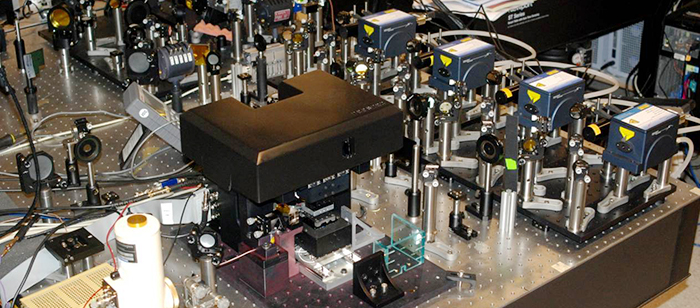PhD defense: Quantum Cascade Laser Arrays for Standoff Photoacoustic Chemical Detection, 5/17

Ph.D. Dissertation Defense
High Power Mid-infrared Quantum Cascade Laser Array
for Standoff Photoacoustic Chemical Detection
Xing Chen
1:00-3:00pm Friday, 17 May 17 2013, TRC CASPR Conference Room
Quantum cascade lasers (QCLs) are compact, portable, powerful semiconductor laser sources with emission wavelengths from mid-infrared (mid-IR) to terahertz (THz) regions of the electromagnetic spectrum. Mid-IR (i.e. wavelengths from 3 to 20 µm) QCLs are of great importance in a wide range of applications such as trace gas sensing, environmental monitoring, free space communication, medical diagnosis and so on. High power QCLs are particularly important to applications such as infrared counter measure (IRCM) and standoff chemical detections. In such applications, the system performances critically depend on the amount of power a QCL can produce. This dissertation includes two major studies: the first part of the dissertation includes design, fabrication and characterization of high power mid-IR QCL arrays; the second part involves standoff chemical detection using QCLs as laser sources and photoacoustic effect as sensing technologies.
In the first part of the dissertation, we design, fabricate and characterize multi-emitter QCL arrays consisting of multiple narrow laser stripes. Simulation results indicate that the proposed multi-emitter laser arrays present much better thermal performance than a broad area laser device, while having the same thermal management ability as a single narrow stripe device. We have successfully fabricated edge emitting and surface emitting QCL arrays with 5 and 16 emitters. Experimental results show that, with the same laser cavity length, a QCL array with 5 emitters produces over 3 times more power than a single emitter laser device. QCL array with 16 emitters generates about 4 W output peak power at wavelength ~7.9 µm. We have also fabricated surface emitting QCL arrays and demonstrated single mode emission.
The second part of the dissertation involves using high power mid-IR QCLs to perform standoff chemical detections based on photoacoustic sensing technologies. Photoacoustic effect is a light-matter interaction effect that involves generation of acoustic waves when a medium absorbs electromagnetic energy from light. It has been known as a sensitive spectroscopic technique for chemical sensing.
Standoff photoacoustic chemical detection with distance more than 41 feet using quantum cascade laser operated at relatively low power, less than 40 mW, is demonstrated. A simplified theoretical model is developed for pulsed laser photoacoustic effect in open-air environment. The standoff photoacoustic signal can be calibrated as a function of different parameters such as laser pulse energy, gas vapor concentration and detection distance. The results yield good agreements with theoretical model. Standoff detection of solid phase explosive chemicals has also been demonstrated by the use of an ultra-sensitive microphone and acoustic reflector. More than 8 feet detection distance is obtained for standoff photoacoustic sensing of explosives.
Committee: Drs. Fow-Sen Choa (Chair), Brian Cullum, Yordan Kostov, Ryan Robucci, Chen-Chia Wang and Li Yan
Posted: May 16, 2013, 12:01 PM